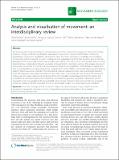Files in this item
Analysis and visualisation of movement : an interdisciplinary review
Item metadata
| dc.contributor.author | Demsar, Urska | |
| dc.contributor.author | Buchin, Kevin | |
| dc.contributor.author | Cagnacci, Francesca | |
| dc.contributor.author | Safi, Kamran | |
| dc.contributor.author | Speckmann, Bettina | |
| dc.contributor.author | Van de Weghe, Nico | |
| dc.contributor.author | Weiskopf, Daniel | |
| dc.contributor.author | Weibel, Robert | |
| dc.date.accessioned | 2015-05-18T09:31:18Z | |
| dc.date.available | 2015-05-18T09:31:18Z | |
| dc.date.issued | 2015-03-10 | |
| dc.identifier | 171386659 | |
| dc.identifier | e2fd59b2-e756-4fdf-b9e6-ae09da366104 | |
| dc.identifier | 84956884087 | |
| dc.identifier | 000215741800005 | |
| dc.identifier.citation | Demsar , U , Buchin , K , Cagnacci , F , Safi , K , Speckmann , B , Van de Weghe , N , Weiskopf , D & Weibel , R 2015 , ' Analysis and visualisation of movement : an interdisciplinary review ' , Movement Ecology , vol. 3 , no. 5 . https://doi.org/10.1186/s40462-015-0032-y | en |
| dc.identifier.issn | 2051-3933 | |
| dc.identifier.other | ORCID: /0000-0001-7791-2807/work/48516836 | |
| dc.identifier.uri | https://hdl.handle.net/10023/6656 | |
| dc.description | This paper presents the interdisciplinary methodological developments resulting from the COST Action IC0903, “MOVE: Knowledge Discovery from Moving Objects” (http://www.move-cost.info/). Funding from the COST Program (European Cooperation in Science and Technology) is gratefully acknowledged, as are the many contributions made by the MOVE participants to the results of this COST action. | en |
| dc.description.abstract | The processes that cause and influence movement are one of the main points of enquiry in movement ecology. However, ecology is not the only discipline interested in movement: a number of information sciences are specialising in analysis and visualisation of movement data. The recent explosion in availability and complexity of movement data has resulted in a call in ecology for new appropriate methods that would be able to take full advantage of the increasingly complex and growing data volume. One way in which this could be done is to form interdisciplinary collaborations between ecologists and experts from information sciences that analyse movement. In this paper we present an overview of new movement analysis and visualisation methodologies resulting from such an interdisciplinary research network: the European COST Action “MOVE - Knowledge Discovery from Moving Objects” (http://www.move-cost.info webcite). This international network evolved over four years and brought together some 140 researchers from different disciplines: those that collect movement data (out of which the movement ecology was the largest represented group) and those that specialise in developing methods for analysis and visualisation of such data (represented in MOVE by computational geometry, geographic information science, visualisation and visual analytics). We present MOVE achievements and at the same time put them in ecological context by exploring relevant ecological themes to which MOVE studies do or potentially could contribute. | |
| dc.format.extent | 24 | |
| dc.format.extent | 3382944 | |
| dc.language.iso | eng | |
| dc.relation.ispartof | Movement Ecology | en |
| dc.subject | Movement ecology | en |
| dc.subject | Animal movement | en |
| dc.subject | Trajectories | en |
| dc.subject | Spatio temporal analysis | en |
| dc.subject | Spatio-temporal visualisation | en |
| dc.subject | Geographic information science | en |
| dc.subject | Computational geometry | en |
| dc.subject | Visualisation | en |
| dc.subject | Visual analytics | en |
| dc.subject | Interdisciplinary developments | en |
| dc.subject | QH301 Biology | en |
| dc.subject | 3rd-DAS | en |
| dc.subject.lcc | QH301 | en |
| dc.title | Analysis and visualisation of movement : an interdisciplinary review | en |
| dc.type | Journal article | en |
| dc.contributor.institution | University of St Andrews. Geography & Sustainable Development | en |
| dc.contributor.institution | University of St Andrews. Bell-Edwards Geographic Data Institute | en |
| dc.identifier.doi | 10.1186/s40462-015-0032-y | |
| dc.description.status | Peer reviewed | en |
This item appears in the following Collection(s)
Items in the St Andrews Research Repository are protected by copyright, with all rights reserved, unless otherwise indicated.

